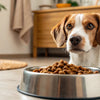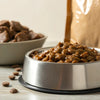How Many Ounces of Wet Food for Dogs: A Complete Guide for Responsible Pet Parents
- Houndsy
Table of Contents
- Introduction
- Understanding Your Dog's Nutritional Needs
- Wet Dog Food Feeding Guidelines
- The Benefits of Wet Dog Food
- How to Mix Wet and Dry Food
- Houndsy: Elevating the Dog-Feeding Experience
- Conclusion
Introduction
Did you know that approximately 59% of dogs in the United States are classified as overweight or obese? This alarming statistic underscores the crucial importance of understanding our pets’ dietary needs, particularly when it comes to wet food. As responsible pet owners, we strive to provide our dogs with the best nutrition possible, and knowing how many ounces of wet food to serve daily is an essential part of that commitment.
In this blog post, we will delve into the specific feeding guidelines for wet dog food, explore the variables that affect how much food your dog should be eating each day, and ultimately, how this knowledge can improve your dog's health and well-being. By the end of this article, you will have a clearer understanding of how to determine appropriate portion sizes, ensuring that your four-legged friend enjoys a balanced and nutritious diet.
We’ll also discuss how Houndsy’s innovative feeding solutions can make your daily pet care routine simpler and more enjoyable. We invite you to reflect on your own pet's feeding habits as we guide you through this essential topic, empowering you to make informed choices.
Understanding Your Dog's Nutritional Needs
When it comes to feeding our dogs, a one-size-fits-all approach simply won't suffice. Each dog is unique, and several factors must be considered to determine the optimal amount of wet food. Here are the key influences that affect daily feeding amounts:
1. Dog's Weight
Your dog's weight is perhaps the most significant factor in determining how much wet dog food they need. As a general guideline, the more your dog weighs, the more food they require. For example, a 10-pound dog may need approximately 3 to 4 ounces of wet food daily, whereas a larger dog weighing around 50 pounds may need between 12 to 16 ounces.
2. Activity Level
Another critical element is your dog's activity level. Highly active dogs require more calories to maintain their energy levels, while sedentary or older dogs may need fewer calories to keep their weight in check. An active dog might need around 30% more food than a couch potato counterpart of the same weight.
3. Age and Life Stage
Puppies, adult dogs, and senior dogs have varied nutritional requirements that should influence how much wet food they receive. Puppies typically require more food per pound of body weight since they are growing rapidly. Conversely, senior dogs may need less food due to decreased activity levels and a slower metabolism.
4. Health Status
Some dogs face specific health issues that affect their dietary needs. For instance, dogs with diabetes or kidney problems may need special dietary considerations. Always consult your veterinarian about your dog's specific health conditions to ensure you are meeting their unique nutritional requirements.
Wet Dog Food Feeding Guidelines
With a clearer understanding of the influencing factors, let’s move on to general feeding guidelines for wet dog food based on weight and daily caloric intake. Most reputable wet dog food brands will provide feeding recommendations on their packaging, which can help you determine the right amount to serve.
General Feeding Recommendations
Here’s a simplified overview of recommended wet food serving sizes by weight:
- For small dogs (up to 20 lbs): 3 ounces of wet food per 3-4 lbs of body weight.
- For medium dogs (21-50 lbs): 1 can (typically 12.5 oz) per 10-15 lbs of body weight.
- For large dogs (51 lbs and above): 1 can (12.5 oz) per 15-20 lbs of body weight.
Example Calculations
To illustrate how to determine the correct amount of wet dog food, here are some hypothetical scenarios:
-
Example 1: A 15-pound dog may need about 5 to 6 ounces of wet food per day. If you’re using a 3 oz can, you would need approximately 2 cans each day.
-
Example 2: An active 60-pound dog may require around 16 to 18 ounces per day. If you are using a 12.5 oz can, that would amount to about 1.5 cans each day, divided into meals.
Adjusting Portions
Monitoring your dog's weight is essential. If your dog is gaining weight, consider slightly reducing their food intake. Conversely, if your dog is losing weight or seems less energetic, it may be necessary to increase their portions.
The Benefits of Wet Dog Food
Choosing to incorporate wet food into your dog's diet offers several advantages worth considering.
1. Hydration
Wet food contains a higher moisture content than dry kibble, which can assist in keeping your dog hydrated—especially valuable in hot weather or for dogs that do not drink enough water.
2. Palatability
Many dogs find wet food more appealing due to its aroma and texture. This quality makes it especially beneficial for picky eaters or dogs who experience dental issues.
3. Nutritional Variety
Wet food generally provides a more varied range of nutrients, and many brands focus on incorporating high-quality proteins and wholesome ingredients. Mixing wet food with dry kibble can create a balanced diet that meets your dog's nutritional requirements effectively.
4. Convenience
Wet food can be quick and easy to serve and store in larger quantities—making meal prep more straightforward for busy pet owners.
How to Mix Wet and Dry Food
Many dog owners choose to blend wet and dry food to provide a varied diet that keeps mealtime exciting. To do this successfully:
-
Adjust Portions: To avoid overfeeding, you often need to reduce the amount of dry food when adding wet food to your dog’s meals. A general rule is to decrease the dry food portion by about 1/3 cup for every half can of wet food included.
-
Monitor Caloric Intake: The total caloric intake should still align with your dog’s ideal weight and activity level.
-
Experiment with Ratios: Every dog is different! You may need to experiment to find the ideal ratio of wet to dry food that your dog enjoys while meeting their nutritional needs.
Houndsy: Elevating the Dog-Feeding Experience
At Houndsy, we understand that feeding your dog should be as enjoyable and functional as possible. We are delighted to introduce our flagship product, the Houndsy Kibble Dispenser. It's designed with modern pet owners in mind, combining practicality with aesthetic appeal.
Features of the Houndsy Kibble Dispenser
-
Convenient Crank: The dispenser features a user-friendly crank that allows effortless dispensing of the perfect portion without bending down—making mealtime easier on your back.
-
Beautiful Design: The Houndsy Kibble Dispenser boasts a mid-century modern aesthetic that complements your home decor while providing reliable functionality.
-
Large Storage Capacity: With a capacity of 25-30 lbs, our dispenser minimizes the need for frequent refills and simplifies storage of both wet and dry food.
-
BPA-Free Liner: Keeping your dog’s food fresh and safe is a priority, which is why we’ve included a BPA-free liner.
-
Auto-Locking Mechanism: Designed to prevent accidental dispensing by curious pets or children, this feature ensures that mealtime stays mess-free.
Discover how the Houndsy Kibble Dispenser can revolutionize your dog-feeding experience and enhance the time you spend with your pet by visiting our product page here.
Conclusion
Understanding how many ounces of wet food to feed your dog daily is crucial for their health and overall well-being. By taking into account factors such as weight, activity levels, age, and health status, we can tailor our dog’s diet to meet their unique needs.
As passionate pet parents ourselves, we at Houndsy are dedicated to simplifying the feeding process through innovative design and functionality. Our Houndsy Kibble Dispenser is one way to enhance your daily feeding rituals, ensuring both convenience and joy for you and your furry friend.
We encourage you to reflect on your current feeding routine and consider how our solutions can elevate it. By making informed choices and regularly monitoring your dog’s health, you'll set the foundation for a long, happy life together.
Frequently Asked Questions
-
How do I determine the right amount of wet dog food for my dog?
- Begin by assessing your dog’s weight, age, activity level, and consulting the feeding guidelines on the wet dog food packaging. Adjust as necessary for your dog’s individual needs.
-
Can I mix wet dog food with dry food?
- Yes! Many pet parents blend wet and dry food to create a balanced meal that provides the advantages of both. Just remember to modify the total food amount to account for the calories in both types.
-
How often should I feed my dog wet food?
- Most adult dogs do well with two meals per day, while puppies often require three to four meals. Tailor the quantity based on whether you're feeding multiple meals.
-
What if my dog is overweight?
- If your dog is overweight, it’s advisable to consult your veterinarian for personalized recommendations regarding their feeding and exercise plan.
-
Are there specific dietary needs for senior dogs?
- Senior dogs typically require lower calorie foods and may benefit from diets that include joint-supporting nutrients. Always consult your veterinarian for tailored dietary advice.
By understanding these guidelines and utilizing the Houndsy Kibble Dispenser, we can enhance the feeding experience for both you and your beloved dog. For more details on how our products can revolutionize your pet care routine, check out the Houndsy Kibble Dispenser here.












